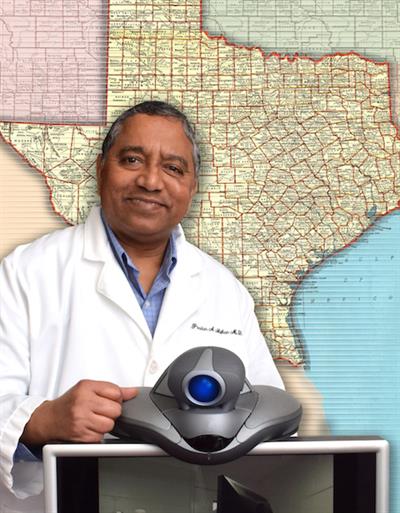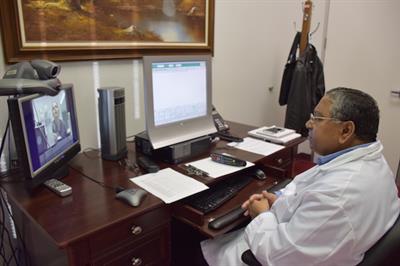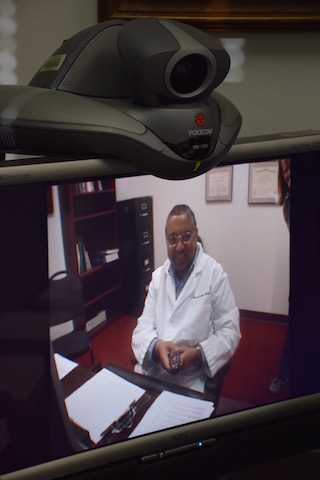
Dr. Pradan Nathan used to drive hundreds of miles to see psychiatric patients at Texas Department of Criminal Justice prison units across the state. These days, he doesn’t drive at all.
As a telepsychiatrist for UTMB Correctional Managed Care, Nathan sees up to 20 patients a day in the comfort and safety of his office in Conroe.
“I can easily see patients on death row in the Polunsky Unit in the morning and then turn my computer screen to the Stiles Unit in the afternoon,” Nathan says. “The two maximum security units are nearly 100 miles apart, so telemedicine has made a big difference. Instead of driving all day, I can see more patients and really focus on what they are saying.”
Nathan has practiced psychiatry for 40 years and has helped spearhead telemedicine and electronic medical records applications in the Texas prison system. With a severe shortage of psychiatrists in Texas and around the country, telemedicine has become a way to stretch the reach of a few and increase access to behavioral healthcare for long-distance patients. In 2015, CMC telepsychiatrists recorded nearly 46,500 patient encounters.
I meet up with Nathan on a Wednesday morning, just before his clinic begins at 8:30 a.m. His office is one of five telepsychiatry-equipped rooms in the CMC administrative offices.
He immediately strikes up an energetic conversation about a recent conference in Boston, where he learned about the latest advances in psychopharmacology. He did his original MD/PhD research in India, focusing on psychosocial factors in murderers and has worked with UTMB and TDCJ since 1992. Considering he works all day long with offenders—many of whom have life sentences—I’m immediately taken by Nathan’s positive attitude and passion for his profession.

He explains his office set-up as he sits down in front of two computer screens. One is for email and pulling up patient electronic medical records, and the other is for videoconferencing with patients. Nathan adjusts a webcam as he dials into the Stiles Unit in Beaumont.
“Good morning, Ms. McDonald!” Nathan says warmly to the correctional clinical associate at Stiles who appears on the screen. I’m surprised by how clear the picture is—there’s no audio delay or blurry images. The two casually discuss the order of patients for the morning, and Nathan glances through the EMR of the first patient before he arrives.
“Right now, Stiles has nearly 700 patients on psychiatric medication out of a population of 2,800,” Nathan says. “We’ll see them all in rotation, but some need to be seen more often depending on their situation. We have a team right there in the unit itself that includes a chief psychologist, three psychologists, two social workers and, of course, medical physician assistants and a medical physician. If a patient needs to be seen in more detail, they’ll set up an appointment with me. We have 100 percent access to care, which means whenever an offender fills out an I-60, or sick call request, somebody has to see them within 48 hours.”
There’s a slight delay in starting the clinic because the inmate “count” is off and everything is at a stand-still while prison officers account for all inmates. But once we get the all-clear, the pace picks up quickly.
His first patient suffers from depression and is experiencing spasms as a side

effect of his medication. Nathan zooms in with his camera to get a closer look at the facial spasms and makes a change to his medication before scheduling a follow-up appointment in a few months.
He asks the patient if he has any questions for him and explains why depression occurs.
“Sometimes, people get hopeless thinking about the future, or something happens in their family. In prison, people can get stuck with others that they don’t necessarily like. In the ‘free world,’ you can avoid people, but in prison, you can’t,” Nathan says. “The people who manage it well exercise regularly, keep up with their faith and have good family connections.”
As soon as one patient stands up to leave, another patient enters the room and sits down in front of the camera. Nathan spends more time with new patients, going over their history and assessing whether they have a mental illness. If so, he tries to determine if it should be treated with medication or therapy. In extreme cases, he sends patients to one of two psychiatric hospitals that serve the prison system.
“Walk step-by-step with me and we’ll get you patched up,” he tells a patient.
The most common issues include depression, anxiety, mood changes, neurological disorders and psychosis. Many patients also have comorbidities, like hepatitis C and diabetes, so Nathan is careful to make sure none of the medications he prescribes interact negatively.
One patient experiences a psychomotor seizure during an appointment and starts repeatedly yelling for help. Nathan immediately notifies the clinical associate and has the on-staff medical team keep an eye on the patient until he is no longer disoriented.
By lunchtime, he’s seen nine patients with no breaks in between. Several of the offenders have been seeing Nathan for years and have a friendly relationship, talking about the Final Four Championship along with their usual business.
We grab a quick lunch at a Chinese buffet down the street before heading back for the afternoon session, when he’ll be seeing patients who are segregated in a different building at Stiles.
“With segregated patients, the timing of everything depends on security, purely,” Nathan says. “They have to escort each inmate from his cell to the appointment. If they are short on security officers, appointments may be canceled. The other day, one inmate set fire to his cell and everything had to be stopped so all the guards could make sure no one was injured.”

Nathan oftentimes stays in his office until 8 p.m., finishing up paperwork and carefully looking through each person’s past records again to make sure he made the right decision regarding their care. If he’s had a particularly tough day, he’ll take some time out.
“When things happen, it’s hard not to feel it,” Nathan says. “If someone threatens to kill themselves right in front of you or kill someone else, it takes some time to decompress. I have to sit down at the end and take a few minutes for myself.”
Still, Nathan wouldn’t trade his job for any other. He doesn’t ask his patients what they’ve done to end up in prison. Rather, he treats them with the care and compassion that he would for any other patient—whether in person or through video.
“Once they know they are being heard, they start to respond,” he says. “My hope is to give them direction so they are able to understand their mental problems and do something positive about them. When they are doing well, you can’t beat that.”